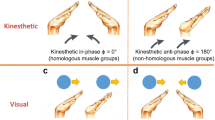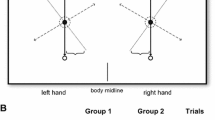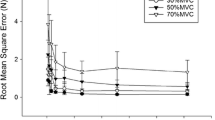Abstract
The purpose of the experiment was to determine the influence of Lissajous feedback on 1:1 bimanual coordination patterns (0°, 90°, and 180° phase lags) when the movement amplitudes of the two limbs were different (30°, 60°). The present data supports the notion that the lead–lag relationship as well as amplitude assimilation observed in the literature can be partially attributed to the visual-perceptual factors present in the testing environment. When participants are provided integrated feedback in the form of Lissajous plots much of the lead–lag and amplitude assimilation effects were eliminated, and relative phase error and variability were also greatly reduced after only 3 min of practice under each condition.

Similar content being viewed by others
References
Buchanan JJ, Ryu YU (2006) One-to-one and polyrhythmic temporal coordination in bimanual circle tracing. J Mot Behav 38:163–184
de Poel HJ, Peper CE, Beek PJ (2008) Laterally focused attention modulates asymmetric coupling in rhythmic interlimb coordination. Psychol Res Psychol Forsch 72:123–137
Debaere F, Wenderoth N, Sunaert S, Van Hecke P, Swinnen SP (2003) Internal vs external generation of movements: differential neural pathways involved in bimanual coordination performed in the presence or absence of augmented visual feedback. Neuroimage 19:764–776
Heuer H, Klein W (2005) Intermanual interactions in discrete and periodic bimanual movements with same and different amplitudes. Exp Brain Res 167:220–237
Heuer H, Klein W (2006) Intermanual interactions related to movement amplitudes and endpoint locations. J Mot Behav 38:126–138
Kovacs AJ, Buchanan JJ, Shea CH (2009a) Bimanual 1:1 with 90° continuous phase: difficult or easy? Exp Brain Res 193:129–136
Kovacs AJ, Buchanan JJ, Shea CH (2009b) Perception-action coordination dynamics: using scanning trials to assess coordination tendencies. Neurosci Lett 455:162–167
Kovacs AJ, Buchanan JJ, Shea CH (2010a) Impossible is nothing: 5:3 and 4:3 multi-frequency bimanual coordination. Exp Brain Res (in press)
Kovacs AJ, Buchanan JJ, Shea CH (2010b) Perceptual and attentional influences on continuous 2:1 and 3:2 multi-frequency bimanual coordination. J Exp Psychol Hum Percept Perform (in press)
Marteniuk RG, MacKenzie CL (1980) A preliminary theory of two-hand co-ordinated control. In: Stelmach GE, Requin J (eds) Tutorials in motor behavior. North-Holland, Amsterdam
Marteniuk RG, MacKenzie CL, Baba DM (1984) Bimanual movement control: information processing and interaction effects. Q J Exper Psychol 36A:335–365
Peper CE, de Boer BJ, de Poel HJ, Beek PJ (2008) Interlimb coupling strength scales with movement amplitude. Neurosci Lett 437:10–14
Ryu YU, Buchanan JJ (2004) Amplitude scaling in a bimanual circle-drawing task: pattern switching and end-effector variability. J Mot Behav 36:265–279
Sherwood DE (1994) Interlimb amplitude differences, spatial assimilations, and the temporal structure of rapid bimanual movements. Hum Mov Sci 13:841–860
Spijker W, Heuer H (1995) Structural constraints on the performance of symmetrical bimanual movements with different amplitudes. Q J Exp Psychol 48A:716–740
Weigelt C, de Oliveira SC (2003) Visuomotor transformations affect bimanual coupling. Exp Brain Res 148:439–450
Author information
Authors and Affiliations
Corresponding author
Rights and permissions
About this article
Cite this article
Kovacs, A.J., Shea, C.H. Amplitude differences, spatial assimilation, and integrated feedback in bimanual coordination. Exp Brain Res 202, 519–525 (2010). https://doi.org/10.1007/s00221-009-2154-1
Received:
Accepted:
Published:
Issue Date:
DOI: https://doi.org/10.1007/s00221-009-2154-1




